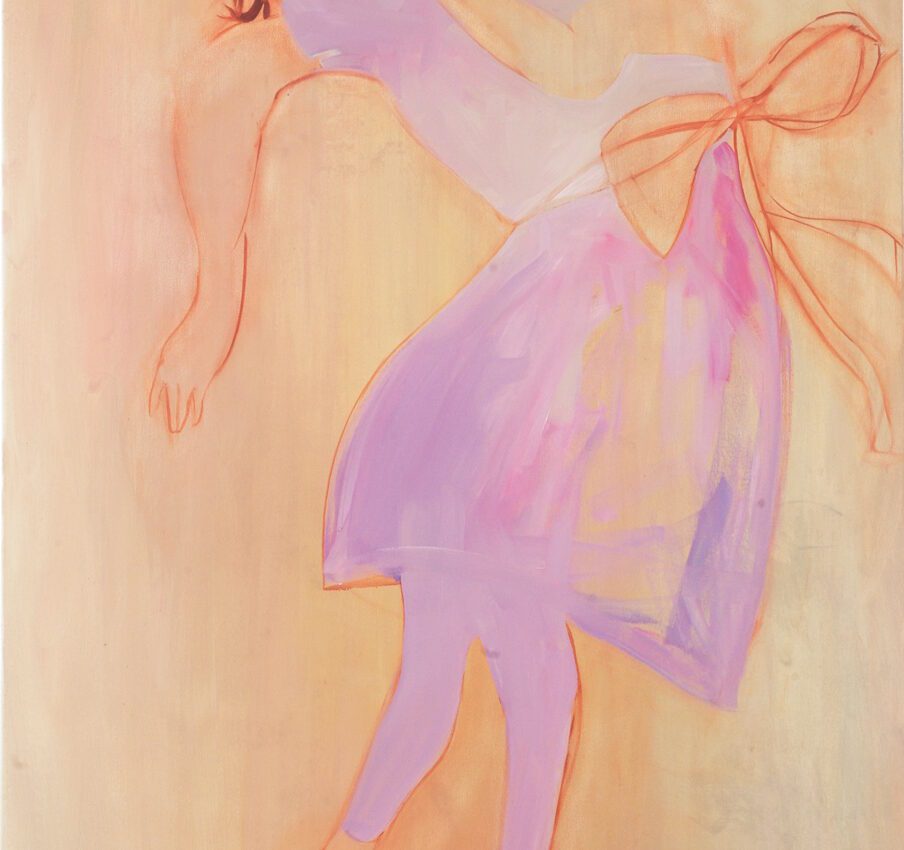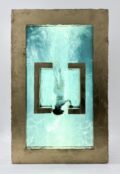For painter Keiko Kimoto art is about presence. Watching the artist face the daunting emptiness of a large canvas, surrounded by private view attendees and accompanied by a harpist, we were waiting in the hush, expectant as the artist stared into the abyss of possibility.
Kimoto (B. 1977) resides and works in Toyooka, Tajima Province Japan but has roots in Berlin where for over 25 years she studied and honed her own style of painting. A mixture of Japanese and Western techniques, her paintings exist in the dynamic between figurative and abstract disciplines. A signature element of her work is in blurring the boundaries of story led and graphic art, an area she explores by neither excluding narrative symbols nor planning them. Her art comes from how she paints, a process that allows certain aesthetic connections to emerge during the act of painting. Exhibiting in Japan, Germany, France her work has found a worldwide audience of people drawn to the mysterious internal landscapes she captures on canvas.
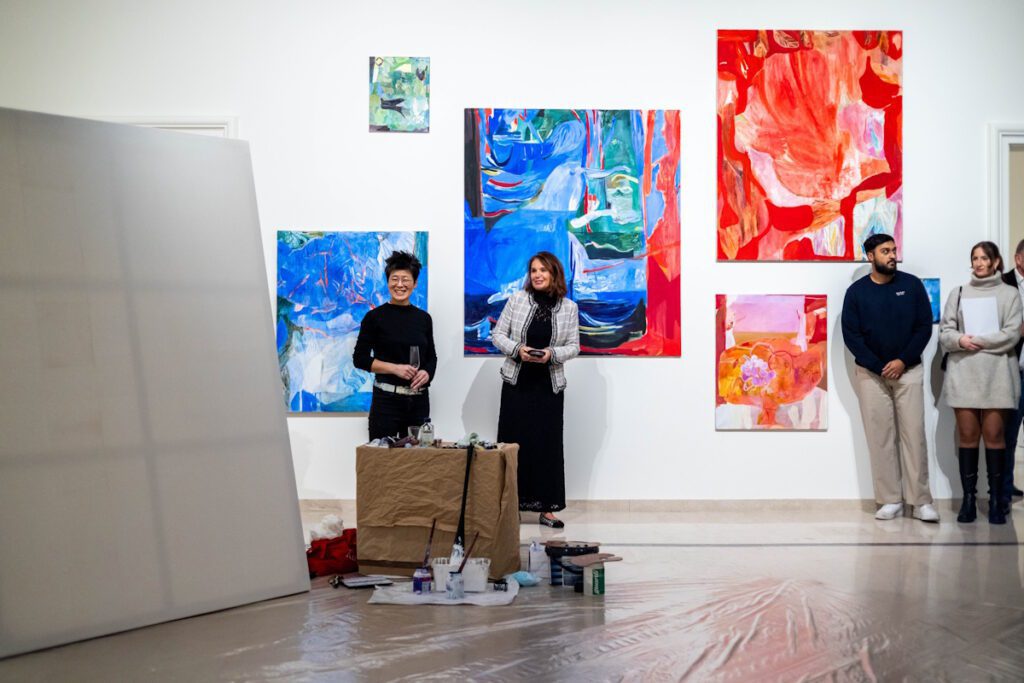
Then the moment came. Dancing forward, the barefoot Kimoto became a vessel for action and pushed a thick wide line down the side of the canvas with a painter’s mop. The white paint heavily applied created valleys and peaks on the now topographic canvas. Something had happened and Kimoto stepped back to account for this new reality.
What was the inspiration? How did the moment arrive? Perhaps it can never be described and its power lies in only ever being understood through the outcome. This first vital instinctual action, a sort of whimsical, pale, textured gesture, created a pointed beginning. From there, other elements followed; lines, washes, and connecting tissue of paint. Slowly, something emerged, while more abstract than Kimoto’s exhibited works, it started to grow and with every following stroke claimed the territory. After an hour Kimoto stopped and beaming her infectious smile, bowed. Whatever the painting was, and whether it was ‘finished’ remained lingering questions for the audience. For the artist, that was enough, the demonstration was at an end.
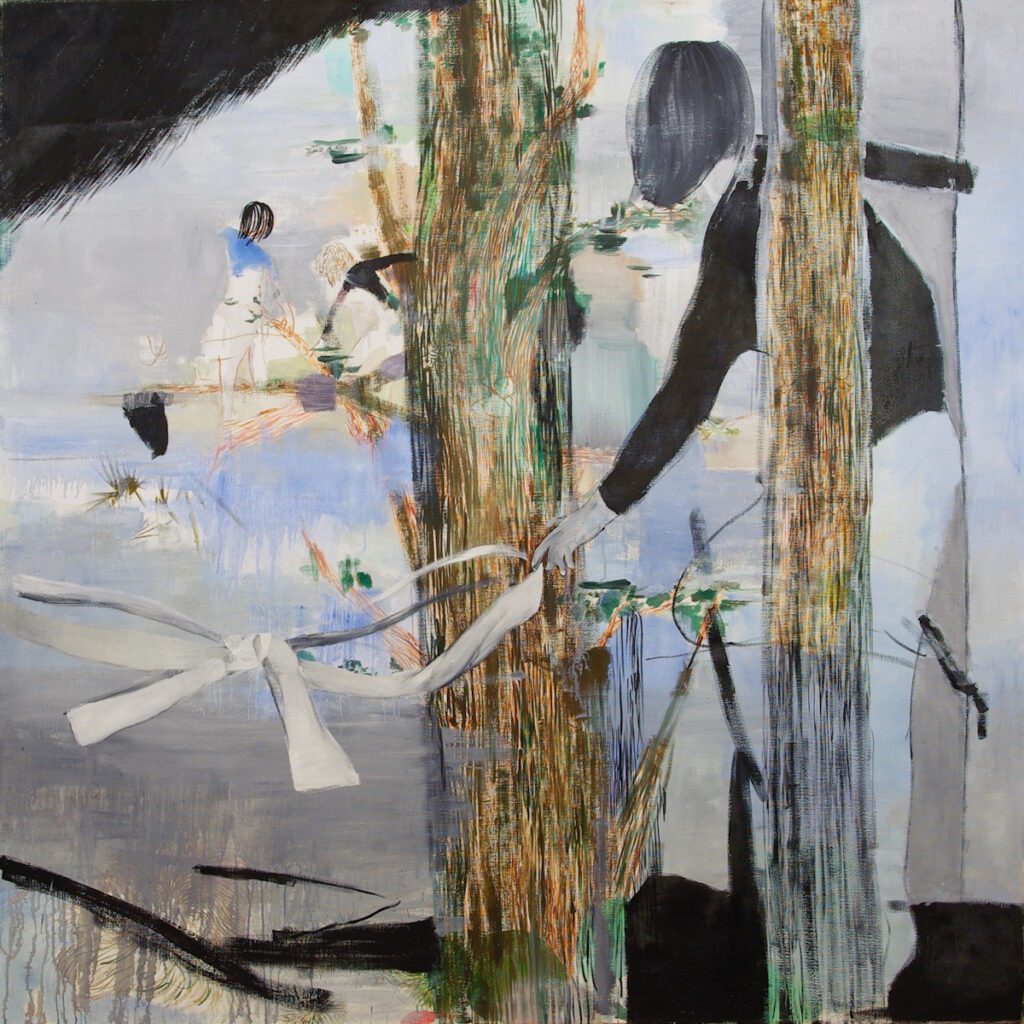
Painting publicly is a bold move, especially for an artist who works without defined maps or plans. However watching an artist paint is a rare and titillating pleasure, you witness the reactions and their resulting effects in real time, however it’s a tease as you neither get to see the final result nor be fully party to the plan.
“I draw a line without memory and without an idea. The colour harmonizes (sic) visually with my feelings, connecting with my emotions.”
Kimoto says that she finds her work in doing. A process about sublimating the intellectual ordering of ideas in order to find something in the forms that are directly produced through the act of painting. From watching Kimoto this method seems to have a parallax function where the artist focuses in on a detail and reacting to that makes another brushstroke of a different quality, which itself changes the entire aspect of the canvas. Using a different colour or texture in each event increases the resonance of each action and in this way the artist seems to create the maximum amount of drama during the process itself. Kimoto plays with the canvas, painting so that spectral scenes and characters emerge as an echo of the emerging forms she traces. Her paintings show sylvan figures drifting through forests or as in her later works, within abstract vistas of colour. Why the change from narrative to abstract? The artist says simply that she needed to pursue something different. This restless, searching spirit makes Kimoto’s work compelling and it’s this character that first attracted Claudia Limacher and Tim Zhuang of Impulse gallery.
Founded in 2020 Impulse gallery bases itself firmly in contemporary art which is unusual for Swiss galleries which tend to focus on canonical works steeped in art history. As such a new space amongst the lakeside mediaeval beauty of Lucerne is a delightful anomaly. Long known as a beautiful city, Lucerne boasts a bohemian atmosphere, with energetic cafes and bars plying an artisanal trade to the last European vestiges of unreconstructed hipsters. For Kimoto’s show, financially savvy art-patrons mingled with several local creative cadres discussing the art somewhat in awe of seeing new work outside of Berlin or Paris. Providing a serious place for art for these sorts of connections seems to be both a strong and attainable strategy for the gallery and Lucerne itself. Most attractively this pivotal moment is happening now with each show attracting collectors from beyond the shorelined banks of the Swiss lake.
“The exhibition offers a rare glimpse into Keiko Kimoto’s artistic evolution over the past two decades, inviting viewers to explore the delicate intersection between dreams and reality. Her ability to harmonize precision and spontaneity creates a captivating narrative that resonates with the universal language of art,” – Claudia Limacher, Founder of Impulse Gallery.
Curated by Limacher and Alfredo Luis Gonzalez Parra, this exhibition of Kimoto’s work brings together pieces from the last decade in a variety of mediums, painting, murals and sculptures. Comparing her paintings, the earlier works have a more personal narrative flavour whereas the later, more abstract paintings appeal to wilder, more existential sensations – they tend to operate with a broader almost cosmic scope.
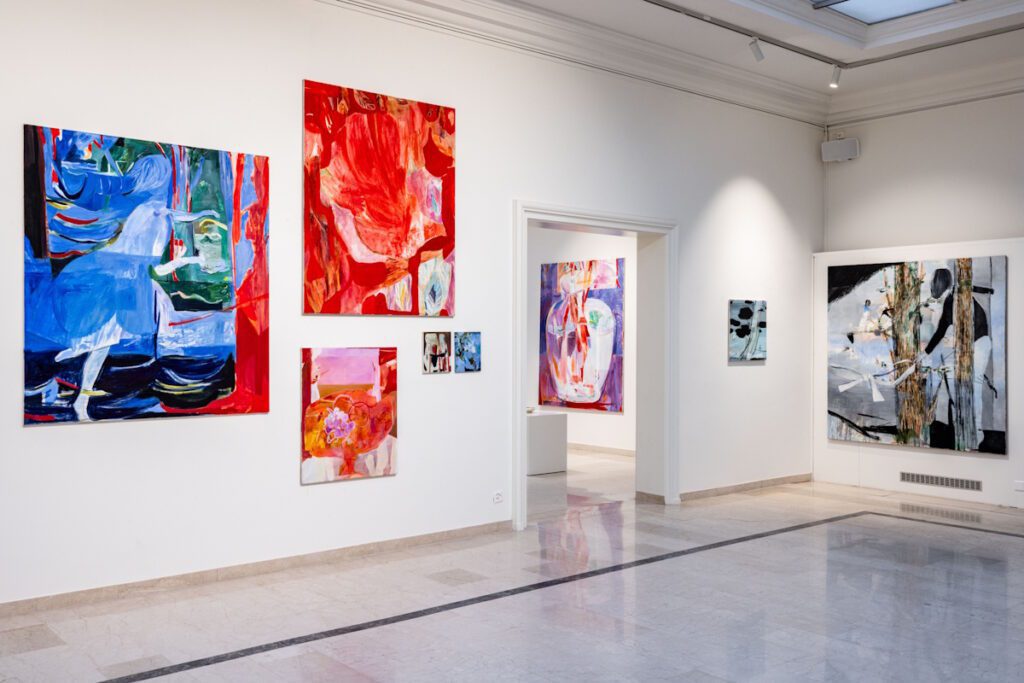
Veils of colours pan across the canvas, spectral profiles of rooms and forests create vectors of space bounded by colour. Existing in neither the foreground or the background ghostly figures emerge, captivated by some internal action which is indicated externally but conveys an internal preoccupation. This meditative repose might be direct (for instance a fish, book or flower) but the character’s attention suggests the interaction has triggered a memory, or echoes of remembrance, which in themselves have shades of being. The figures are often blankly youthful, depicting the sort of l’esprit of being that describes how we see ourselves in dreams and in the unreflected moments of situatedness. When we somehow forget the us created by history, and are similarly reduced and expanded as reactive agents of feeling. Kimoto’s art functions by conveying this almost telepathic sense in the same way as Matisse’s dancers or the surreal works of Miro work to we recapture in a waking state the flow of self that describes the shadow narrator of dreams.
Kimoto herself is cagey when it comes to the aim of her work. She contends that ‘she paints’ and what emerges out is just that. However, there are certain signature elements, a certain imperfect freedom of line and depiction, and what might be best described as an avoidance of static geometry in favour of the form found by movement and gravity. Eelational embodied forms that occur through the act of painting, a nexus of mind, arm, brush, paint, and the resistance of the canvas creating a path for the artist to follow, before climaxing in a number of manifest events. The lightness of her work conjures moments carved from time, reiterating in-the-now aphorisms such as; you can’t draw the same line twice. Which is true in art as in life – it is and then it’s done.
This will sound familiar to readers aware of the Japanese concept of wabi-sabi. This amorphous concept of embracing the transience of things, where things are fleeting but important. Even by the Japanese themselves this is a concept that’s notoriously hard to define (See In Search of Wabi Sabi with Marcel Theroux, BBC 2009). One supposes that this concept, containing an indivisibility between the pleasure in things and the pleasure in making things, has rough analogues in the West to Heidegger’s ideas of tools as being simultaneously what is at-hand and also the things that are purpose fashioned.
Rather than rush to your bedside copy of Being and Time, one way to approach wabi-sabi might be to consider the opposite of disposableness and adjust that to include the transient so that you are the generative constant in a world of opportune flux. In this concept everything is present, useful and decided by the flow of a life to reach you in the state perfect for your imperfection. Aesthetically, this manifests as objects created with signal gestures that carry the devotion of the craftsperson not to perfection but to growth and improvement, perfect moments of receptive student-mind rather than funeral completion. In pottery this might be achieved by highlighting the materiality of the object; coarse bits in the clay, variations in the glaze, a graceful waver in a decorative line. Masters make much less overt statements achieving both a sensual balance and transcendent beauty in the subtle humanising of classic forms such that the aura of an object contains within it an undeniable pulsing life, and if that isn’t art then nothing is.

Kimoto’s work is, and perhaps always will be, moments in a line of enlightening progress. Searching refinements, taking the elements of painting and working them into a refined human context touching the unconscious. Her latest works successfully invite the viewer into a fluid four-dimensional world that we often call dreamlike – perhaps only because ideas of the concrete ethereal are alien to us. Just as the characters in her earlier works have retreated, maybe future works will see minimal displays of the shadow narrator and the scenes themselves will contain further opacity and thus reach something universal. Such a point of wabi-sabiness or ahistorical narrative balance would see the artist’s gentlest shift in texture cause the expanse of human experience to explode.
Okurerutaiyou – Delayed Sun, Keiko Kimoto, 29 February – 13 April 2024
Impulse Gallery, Haldenstrasse 19,6006 Lucerne, Switzerland
www.impulsegallery.com
@impulsegallery
Photography: Pawel Streit

The aim of art is to represent not the outward appearance of things, but their inward significance. – Aristotle

